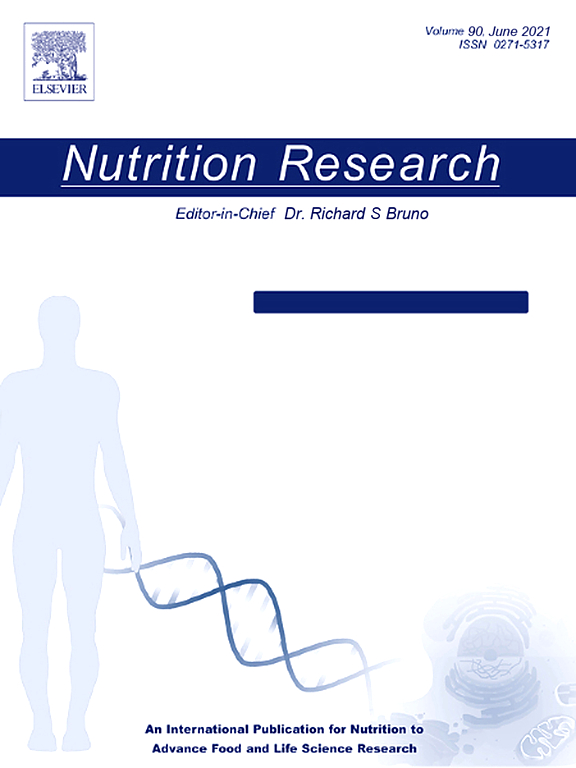Dietary inflammatory index as a modifiable risk factor for sarcopenia in adults with type 2 diabetes: A cross-sectional study
IF 3.1
3区 医学
Q2 NUTRITION & DIETETICS
引用次数: 0
Abstract
There is growing evidence that a proinflammatory diet contributes to the increased risk of sarcopenia by exacerbating low-grade inflammation and insulin resistance, ultimately inducing muscle loss in adults with type 2 diabetes. This study aimed to analyze the association of dietary inflammatory index (DII), physical activity level, and body composition with sarcopenia in adults with type 2 diabetes. The hypothesis of this study was that higher DII increases the risk of sarcopenia. This cross-sectional study was conducted with 249 adults aged 50 years and older with type 2 diabetes who were admitted to the Internal Medicine Department of a tertiary hospital in Türkiye. Nutritional status was determined by 24-hour recall, dietary inflammatory status by energy-adjusted-DII, and physical activity by the International Physical Activity Questionnaire-Short Form. Muscle strength was measured by handgrip dynamometer, body composition analysis was measured by bioelectrical impedance method, and sarcopenia was defined according to EWGSOP-2 criteria. The mean age of the participants was 62.1 ± 6.9 years and the prevalence of sarcopenia was 15.7%. Handgrip strength and appendicular skeletal muscle mass significantly decreased with increasing DII score from tertile 1 to 3 (P < .05). A higher DII score was an independent risk factor for sarcopenia (odds ratio = 2.36, 95% confidence interval: 1.25-4.47, P = .008). This study shows that increased DII was independently associated with sarcopenia in adults with type 2 diabetes after adjustment for potential confounders. Dietary strategies aimed at reducing the potential for inflammation through dietary patterns rich in antioxidants, fiber, and omega-3 fatty acids may be useful in managing the risk of sarcopenia in adults with type 2 diabetes aged 50 years and older.
饮食炎症指数作为成人2型糖尿病患者肌肉减少症的可改变危险因素:一项横断面研究
越来越多的证据表明,促炎饮食通过加剧低度炎症和胰岛素抵抗,最终导致成人2型糖尿病患者肌肉损失,从而增加肌肉减少症的风险。本研究旨在分析成人2型糖尿病患者饮食炎症指数(DII)、身体活动水平和身体成分与肌肉减少症的关系。本研究的假设是较高的DII增加了肌肉减少症的风险。这项横断面研究对249名年龄在50岁及以上的2型糖尿病患者进行了研究,这些患者住进了日本一家三级医院的内科。营养状况通过24小时回忆来确定,饮食炎症状态通过能量调节- dii来确定,身体活动通过国际身体活动问卷-短表来确定。采用握力计测定肌力,采用生物电阻抗法测定体成分,根据EWGSOP-2标准定义肌肉减少症。参与者的平均年龄为62.1±6.9岁,肌肉减少症患病率为15.7%。从第1位到第3位,随着DII评分的增加,握力和尾骨骼肌质量显著降低(P <;. 05)。较高的DII评分是肌少症的独立危险因素(优势比= 2.36,95%可信区间:1.25-4.47,P = 0.008)。本研究表明,在排除潜在混杂因素后,成人2型糖尿病患者体内DII升高与肌肉减少症独立相关。旨在通过富含抗氧化剂、纤维和omega-3脂肪酸的饮食模式来降低炎症的可能性的饮食策略,可能有助于控制50岁及以上2型糖尿病患者肌肉减少症的风险。
本文章由计算机程序翻译,如有差异,请以英文原文为准。
求助全文
约1分钟内获得全文
求助全文
来源期刊

Nutrition Research
医学-营养学
CiteScore
7.60
自引率
2.20%
发文量
107
审稿时长
58 days
期刊介绍:
Nutrition Research publishes original research articles, communications, and reviews on basic and applied nutrition. The mission of Nutrition Research is to serve as the journal for global communication of nutrition and life sciences research on diet and health. The field of nutrition sciences includes, but is not limited to, the study of nutrients during growth, reproduction, aging, health, and disease.
Articles covering basic and applied research on all aspects of nutrition sciences are encouraged, including: nutritional biochemistry and metabolism; metabolomics, nutrient gene interactions; nutrient requirements for health; nutrition and disease; digestion and absorption; nutritional anthropology; epidemiology; the influence of socioeconomic and cultural factors on nutrition of the individual and the community; the impact of nutrient intake on disease response and behavior; the consequences of nutritional deficiency on growth and development, endocrine and nervous systems, and immunity; nutrition and gut microbiota; food intolerance and allergy; nutrient drug interactions; nutrition and aging; nutrition and cancer; obesity; diabetes; and intervention programs.
 求助内容:
求助内容: 应助结果提醒方式:
应助结果提醒方式:


